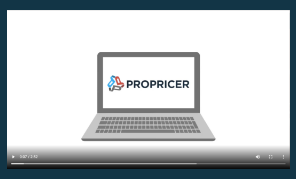You’ve made a contract’s competitive range by submitting a dynamite proposal. So you’re now part of a smaller field of candidates. And one of you will eventually receive the contract award.
Subsequently, you’ve done well in discussions with the agency that may soon be your client.
Now your agency has asked for a best and final offer (BAFO) from each contender. They have requested your BAFO both orally and in writing, according to agency stipulations in FAR 15. 1
You know as well as the officer that a request for a final offer can lead to a better agency price for your deliverables. So concurrently, how do you guarantee fair compensation for yourself should you win? And how do you further increase your victory odds?
Take a look at our eight pro tips below. Some or all of these could help you produce a winning price:
Know that competitors can be cut prior to the offer call, increasing your odds.
Some of your rivals who’ve emerged as part of the competitive range may not survive the discussion phase. Still others may choose to bow out of contract consideration for various reasons—such as a lack of chemistry with the contracting officer or their team—once pre-BAFO discussions are over.
If you’ve been asked for a BAFO, you’ve 1.) Made the post-proposal but pre-BAFO cut, and 2.) As a result, your competitive field has likely narrowed, perhaps substantially. Can this knowledge free you up to be a little more aggressive in your pricing? You bet it can. 1
Be prepared to hear that your initial offer is too high—or low.
Occasionally, the contracting officer you speak with during the discussion period won’t mention your contract price at all. They’ll simply talk about modifications they’d like you to make to your technical proposal, then ask for your BAFO. It’s wise to inquire if you’re priced to win. Don’t leave the discussion with any unconfirmed assumptions about your price proposal. An omission like this can cost you the contract.
The majority of time, you’ll be told your price is either too high or too low. If you’re too high, you’ll need to revise your costs and corresponding prices to align with the number your agency has in mind. Is your overhead unreasonably high? Can you trim costs and offer a better price? Are you shooting for an astronomical profit? If so, your BAFO is your chance to come back down to earth.
If you’re told you’re too low, the agency is worried your deliverables won’t be stellar in terms of quality, and you’re lowballing the contract just to win. Here too, you’ll want to fine-tune the money associated with the product outlined in your proposal. Do any deficiencies called out in the discussion require you to uplevel materials or talent? Do you realistically have all of your costs covered?
In either case, tweak your technical proposal first, then adjust your price proposal to match.
Realize you can lower a final price yourself just to beat the competition.
Remember that you can always lower your final price to the government, even though your agency may not have asked for this.
Obviously you’re trying to beat others in the race with such a move. And your strategy can work. But be careful. If the contract you’re competing for is a cost-reimbursement contract, the procuring agency may ask you for a rationale as to why you lowered your original estimate.
Again, your officers could think the work can’t be realistically done well at your quoted price. Plus, you wouldn’t be contractually bound to complete the contract at that estimated cost in a reimbursement context like this. You may have to do quite a bit of reassuring that you will in fact honor the price you offered. 2
Follow BAFO delivery instructions to the letter.
As with any government proposal action, you’ll be given a definite cutoff date and time for submission of your BAFO; each of your fellow contenders will receive the same. There may be provisions for late submissions, modifications, and withdrawals set forth in the request for BAFO, but don’t count on them. 2
Your proposal journey has likely been an arduous one, as most are. You’ve covered a great distance, but don’t stumble and fall by being late. Not long ago, an agency rejected a BAFO that reached them six minutes late. The contractor then fell out of the competition.1
Know that once you submit your offer, the agency will reevaluate all proposals.
Upon receipt of BAFO from the contractor firms still in the competitive range, the government will re-evaluate all proposals—not just your new prices. The re-evaluation process may change the ranking of contenders from the initial proposal list, or maybe not.
Be sure to address all modifications the agency asked for in the discussion process. For example, if the agency found your original technical proposal lacking in terms of talent cost justification, and you simply change your BAFO price in the pricing proposal instead of modifying your technical proposal too, you’ll drop lower in the final contractor ranking. Worse, the agency could dismiss you altogether.
Stay calm if the agency reopens discussions once you submit your offer.
If there is a need to reopen discussion after BAFO submission, the agency must hold talks with all offerors. This helps keep the playing field level for all contractors still in contention. 2
In this situation, none of the BAFO proposals are agreeable to the government, but the agency involved also has hope that several can eventually meet expectations.
Another potential scenario: The agency discovers an error in their initial proposal evaluation process, so the only way competitors can amend their proposals to meet the new criteria is to talk it out with the agency first.
Lastly: Government needs may have suddenly and drastically changed—for example, a work quantity increase or decrease—and you need time to modify your proposal yet again to reflect this.
Hang in there. You’ve come this far. 1
Be shrewd and save your ideal price for your final offer. (This is risky.)
A situation can arise where you want a full understanding of an agency’s needs and wants. You’ve determined you can only get it through the discussion piece of a BAFO sequence. This can be a very smart idea and also a big risk.
Many would say this is just good business on your part. Typically, you’ll overbid in the initial proposal, then submit your actual price during BAFO. Good things can come to those who wait, but there’s always the chance you’ll never make it into the competitive range if you don’t calculate your first overbid very carefully. 1
Use the proposal management software many agencies use to submit BAFO.
Sometimes you’ll only need to resubmit the portions of your technical and pricing proposals you’ve modified as a result of pre-BAFO discussions. Other times you’ll need to resubmit holistic versions of each proposal if the agency involved calls out extensive deficiencies in your technical proposal.
Either way, it’s smart to submit BAFO-stage pages or complete proposals using the government proposal management software many agencies already use.
On the contracting side, ProPricer Contractor Edition is the platform that empowers you to increase the speed and accuracy of both your BAFO change cycles and original proposal estimates.
Gain instant access to real-time cost and pricing data while staying consistently compliant and secure. ProPricer's database architecture stores all estimates, formulas, and qualitative information; ensures complete visibility into all indirect and direct rates; and lets you manipulate data to customize cost breakdowns and roll-ups.
On the agency side, Propricer Government Edition is the government proposal management software that enables the government to skip reconfiguring your firm’s cost model once you submit a proposal or BAFO file. Cost modeling is basically “one and done.” Your agency contacts will appreciate the time you’ve saved them during any BAFO exercise—and any subsequent proposals you might submit, BAFO or new.
As well, your agency will have the ability to modify proposal rates and estimates at the level of their choice, allowing them to compare multiple versions of the proposal to the original.
Your best and final offers can be your smartest offers, with a little help from the above tips and ProPricer. Request a ProPricer demo here.
Join us for the 2022 Government Contract Pricing Summit:
Cultivating Agile Solutions
- Gain powerful proposal pricing insights from industry thought leaders.
- Network with agency and contractor colleagues from across the nation.
- Learn. Grow. Rethink. Recharge. Refresh.
When: June 14-16, 2022
Where: San Diego, CA, and online
How: Don’t wait. Get a great rate. Register here.
Sources





